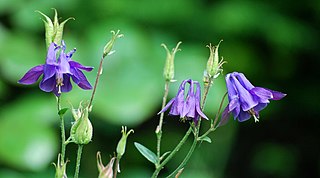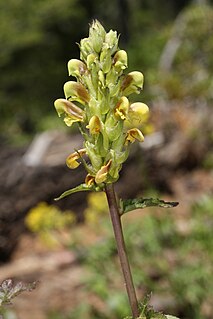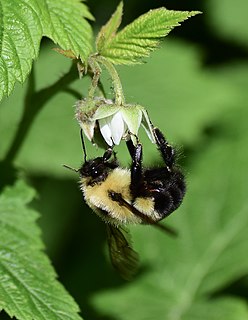
Aquilegia is a genus of about 60–70 species of perennial plants that are found in meadows, woodlands, and at higher altitudes throughout the Northern Hemisphere, known for the spurred petals of their flowers.

Orobanchaceae, the broomrapes, is a family of mostly parasitic plants of the order Lamiales, with about 90 genera and more than 2000 species. Many of these genera were formerly included in the family Scrophulariaceae sensu lato. With its new circumscription, Orobanchaceae forms a distinct, monophyletic family. From a phylogenetic perspective, it is defined as the largest crown clade containing Orobanche major and relatives, but neither Paulownia tomentosa nor Phryma leptostachya nor Mazus japonicus.

George Ledyard Stebbins Jr. was an American botanist and geneticist who is widely regarded as one of the leading evolutionary biologists of the 20th century. Stebbins received his Ph.D. in botany from Harvard University in 1931. He went on to the University of California, Berkeley, where his work with E. B. Babcock on the genetic evolution of plant species, and his association with a group of evolutionary biologists known as the Bay Area Biosystematists, led him to develop a comprehensive synthesis of plant evolution incorporating genetics.

Arthur John Cronquist was an American biologist, botanist and a specialist on Compositae. He is considered one of the most influential botanists of the 20th century, largely due to his formulation of the Cronquist system as well as being the primary co-author to the Flora of the Pacific Northwest, still the most up to date flora for three northwest U.S. States to date. Two plant genera in the aster family have been named in his honor. These are Cronquistia, a possible synonym of Carphochaete, and Cronquistianthus, which is sometimes included as a group within Eupatorium. The former was applied by R.M. King and the latter by him and Harold E. Robinson.

Pedicularis is a genus of perennial green root parasite plants currently placed in the family Orobanchaceae.

Dicentra cucullaria, or Dutchman's breeches, is a perennial herbaceous plant, native to rich woods of eastern North America, with a disjunct population in the Columbia Basin.
Cornelius Herman ("Neil") Muller, born Müller, was an American botanist and ecologist who pioneered the study of allelopathy and oak classification.
Walter Max Zimmermann was a German botanist and systematist. Zimmernann’s notions of classifying life objectively based on phylogenetic methods and on evolutionarily important characters were foundational for modern phylogenetics. Though they were later implemented by Willi Hennig in his fundamental work on phylogenetic systematics, Zimmermann's contributions to this field have largely been overlooked. Zimmermann also made several significant developments in the field of plant systematics such as the discovery of the telome theory. The standard botanical author abbreviation W.Zimm. is applied to species he described.
Áskell Löve was an Icelandic systematic botanist, particularly active in the Arctic.

The two-spotted bumble bee is a species of social bumble bee found in the eastern half of the United States and the adjacent south-eastern part of Canada. In older literature this bee is often referred to as Bremus bimaculatus, Bremus being a synonym for Bombus. The bee's common name comes from the two yellow spots on its abdomen. Unlike many of the other species of bee in the genus Bombus,B. bimaculatus is not on the decline, but instead is very stable. They are abundant pollinators that forage at a variety of plants.

Mertensia paniculata, also known as the tall lungwort, tall bluebells, or northern bluebells, is an herb or dwarf shrub with drooping bright-blue, bell-shaped flowers. It is native to northwestern North America and the Great Lakes.
Birgitta Bremer, Swedish botanist and academic, is professor at Stockholm University, and director of the Bergius Botanic Garden.
Francis Elliott Drouet (1907–1982) was an American phycologist, who collected specimens in the United States, Brazil, Mexico, and Panama.
Jonathan Deininger Sauer was a botanist and plant geographer.
John Maurice Tucker was an American botanist, herbarium director, and leading expert on oak taxonomy.
William "Bill" J. Crins is a botanist, naturalist, and ecologist.
Laurence "Larry" Joseph Dorr is an American botanist and plant collector. He specializes in the systematics of the order Malvales and the family Ericaceae.
Scott Alan Mori was a botanist and plant collector. He specialized in the systematics and ecology of neotropical Lecythidaceae and Amazonian and Guianian floristics.
Harvey Alfred Miller was an American botanist, specializing in Pacific Islands bryophytes.
Barbara Ann Whitlock is a botanist, who earned a PhD from Harvard University, with a dissertation entitled Systematics and evolution of chocolate and its relatives circa 2000, an interest which continues.








